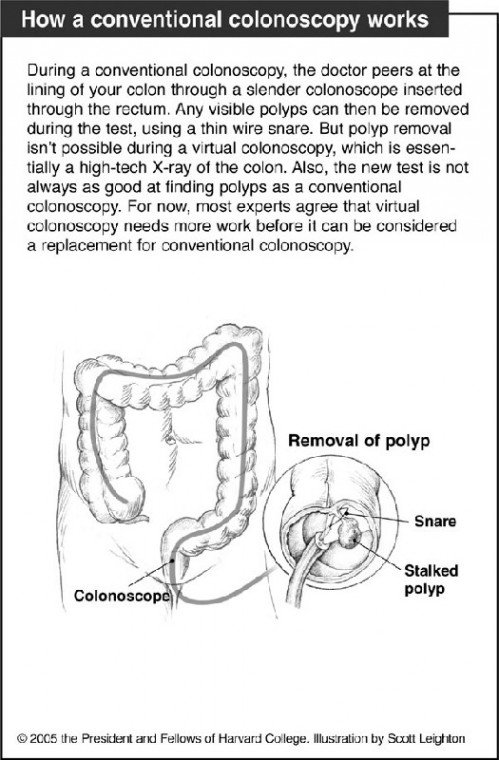Q: How is a
”
virtual
”
colonoscopy different from a regular colonoscopy? Is it just as
accurate?
Q: How is a “virtual” colonoscopy different from a regular colonoscopy? Is it just as accurate?
A: The main difference is that a regular colonoscopy involves putting an instrument inside the body, whereas a virtual colonoscopy does not. A regular colonoscopy uses a colonoscope – a thin, flexible tube with special instruments and a light at the end. The doctor passes the colonoscope up through the rectum and usually can examine the lining of your entire colon (large intestine). For example, the doctor can spot small growths called polyps (some of which can turn into cancer) and actual cancers.
A virtual colonoscopy relies instead on a high-tech X-ray machine called a CT scanner. The machine takes hundreds of wafer-thin “pictures” of the inside of your colon and rectum.
A computer then assembles the pictures into a complete image. The next step is similar to a video game, as doctors “fly through” the image on a computer screen, looking for abnormalities in the lining of the colon.
Virtual colonoscopy offers several advantages to patients. Because no instruments enter the body, there’s no chance that the endoscope will poke a hole in the colon.
But that happens only rarely – only about 1 in 1,000 times with regular colonoscopy. Also, you get painkillers and sedatives during a regular colonoscopy. As a result, someone must drive you home afterward. That’s not required with the virtual test, which doesn’t use drugs.
But virtual colonoscopy has some limitations. For starters, you still have to endure what most people consider the worst part of the experience: cleaning out your system. Whether you have a virtual or a regular colonoscopy, you must stop eating 24 hours beforehand. To further clean out your system, you need to either drink about a half-gallon of an unpleasant-tasting liquid or swallow a lot of pills. Then, be prepared to spend a great deal of time on the toilet.
In addition, regular colonoscopy has one clear advantage compared to virtual colonoscopy. With regular colonoscopy, once a cancer or a polyp is discovered, it can be removed right then and there. The doctor snakes a thin, wire-like device through the colonoscope and snares the polyp.
But virtual colonoscopy only finds polyps; it can’t remove them. If the virtual test detects a polyp, you still need a separate procedure with an endoscope to have it removed.
But the biggest concern has been doubts about virtual colonoscopy’s accuracy. It has missed polyps found by conventional colonoscopy – more than half of them, in some studies. In others, it has been quite accurate. One reason the findings have varied is because the technology is so new. Even the doctors with the most experience interpreting the images do not have much experience.
In light of varying results, most experts believe virtual colonoscopy still needs work before it can be considered a replacement for regular colonoscopy. Whether virtual colonoscopy becomes popular may depend on cooperation between radiologists (who do the virtual tests) and gastroenterologists (who do the regular tests).
Ideally, if a polyp or cancer is found by virtual colonoscopy, a gastroenterologist would be right there, ready to remove it via an endoscope. Another exciting but unproven possibility is so-called subtraction software that lets the CT scanner “see” the colon lining through the contents of the bowel. If that were possible, you wouldn’t need to clean out your system first.
For now, conventional colonoscopy has the most data to support its effectiveness. So, your physician will likely recommend it over a virtual colonoscopy. It’s best to talk with your doctor about your individual risk factors, and when you should be screened.
Although colorectal cancer can occur at any age, most people who develop it are over the age of 50.
Submit questions to the Harvard Medical School Adviser at www.health. harvard.edu/adviser. Unfortunately, personal responses are not possible.












